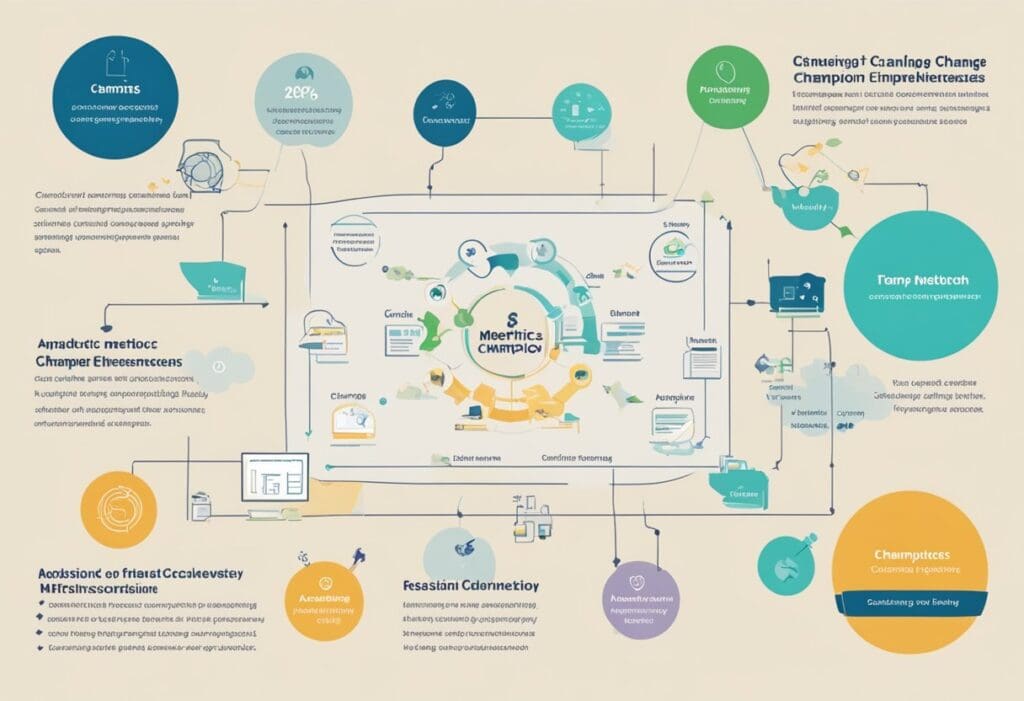In any organization, clear communication and strong leadership are keys to successful change management. Change champions advocate for new initiatives, address concerns, and maintain the momentum needed for continuous improvement. Their ability to foster a positive change culture inspires confidence and commitment among employees, driving the overall success of the organization.
Change champions also collaborate with other leaders to monitor progress and make necessary adjustments. They use their skills to engage and motivate employees, creating a network of support that ensures sustainable change. Knowing how to overcome obstacles and leveraging metrics to assess effectiveness helps them steer the organization toward its goals.
Key Takeaways
- Change champions lead by example and guide employees through transitions.
- Effective communication and a positive culture are essential for successful change.
- Monitoring progress and overcoming obstacles are key responsibilities.
Role and Responsibilities of a Change Champion
A change champion plays a vital part in guiding employees through transitions, leveraging their leadership to have a positive impact on the organization. They focus on helping everyone adapt while ensuring smooth implementation of changes.
Defining the Change Champion Role
A change champion acts as a role model during periods of change within an organization. They embody the qualities needed to adopt new methods and systems. Their role involves being a strong advocate for change and providing a clear example for others to follow. This helps employees understand that change is achievable and benefits both individual growth and the organization’s future.
Core Responsibilities
Change champions are responsible for several key activities. They communicate the vision and goals of the change clearly to all employees. Addressing concerns and providing support are also crucial parts of their job. They ensure that everyone is on the same page and feels confident about the changes being introduced. Monitoring progress and making necessary adjustments also fall within their duties.
Skillset for Success
To be effective, a change champion must possess a unique set of skills. They need to be excellent communicators, capable of addressing diverse audiences with clarity. They should also exhibit strong problem-solving abilities and be open to feedback and new ideas. Creativity and critical thinking skills are important to navigate various challenges. Embracing these skills helps them lead change initiatives successfully.
Collaboration with Leadership
Working closely with leadership is a fundamental aspect of the change champion’s role. They act as a bridge between employees and management, ensuring that the leadership’s vision is effectively conveyed to the broader team. Engaging with key stakeholders and influencing others’ behaviors are essential tasks. Through collaboration, they help align the organization’s strategic direction with the ongoing change efforts.
For more detailed information on the role of a change champion, visit the HR University overview. Additionally, practical tips on becoming an effective change champion can be found at the Mclean.
The Importance of Effective Communication
Effective communication is critical to the success of any change initiative. It ensures that all parties are well-informed, engaged, and empowered to contribute their best.
Facilitating Open Dialogue
Encouraging open dialogue is essential for creating a transparent environment. When you openly communicate with your team, it builds trust and reduces misunderstandings. Open dialogue allows for the free exchange of ideas, ensuring that everyone understands the goals and processes involved in the change.
You should consistently share information about the change, including its purpose and expected results. This transparency helps align everyone’s expectations and reduces anxiety. Use meetings, newsletters, and informal chats to keep communication lines open. Asking questions and actively listening to responses further enhances openness.
Encouraging Feedback
Encouraging feedback is vital for understanding how the change affects everyone involved. Feedback helps identify potential issues early, allowing you to address them before they escalate. It also gives employees a sense of ownership and involvement in the process.
Set up multiple channels for feedback, such as suggestion boxes, surveys, and open forums. This ensures that everyone can find a comfortable way to share their thoughts. Regularly review the feedback you receive and communicate any actions taken in response. This shows your team that their opinions matter and contribute to the change process.
Communication Skills for Change Champions
As a change champion, your communication skills are critical. This includes not just talking but also listening and understanding the concerns of your team. Empathy is a key skill; it allows you to connect with your team members and understand their perspectives.
Developing clear and concise messages is important. Avoid jargon and complex language that might confuse your audience. Tailor your communication to different groups within the organization, addressing their specific concerns and how the change impacts their roles. Practice active listening, where you make an effort to truly understand before responding, and ensure that your body language aligns with your words to avoid mixed messages.
Fostering a Positive Change Culture
A positive change culture is essential for successful change initiatives. Key aspects to focus on include overcoming resistance, building trust, and promoting continuous learning and adaptability.
Overcoming Resistance to Change
Resistance to change is common within organizations. It can stem from fear of the unknown or comfort with the current state. As a change champion, you must address these fears directly and empathetically.
Communicate Clearly: Explain the reasons behind the change and how it benefits both the organization and the individual. Use simple and honest language.
Involve Employees: Engage employees in the change process by seeking their input and involving them in planning and implementation. This builds a sense of ownership.
Set Small Goals: Break down the change into small, manageable steps. Celebrate each achievement to show progress and build momentum.
Building Trust within the Organization
Trust is the foundation of a positive change culture. Without it, employees may feel skeptical or disconnected from the change initiatives.
Be Transparent: Share updates regularly and openly. Discuss both successes and challenges, showing that you are committed to the process.
Lead by Example: Demonstrate the change in your actions. If leadership embodies the change, employees are more likely to follow suit.
Listen Actively: Create opportunities for employees to voice their concerns and questions. Address these openly to build trust and show that their opinions matter.
Promoting Continuous Learning and Adaptability
For a change culture to take root, continuous learning and adaptability must be prioritized. This prepares the organization to navigate future changes more smoothly.
Offer Training: Provide ample training opportunities to equip employees with the skills needed for the change. This reduces anxiety and helps them feel more competent.
Encourage Curiosity: Foster a mindset where questioning and exploring new ideas are welcomed. This encourages innovation and adaptability.
Recognize Efforts: Acknowledge and reward employees who embrace change and demonstrate continuous learning. This motivates others to follow their example and contributes to a culture of growth and adaptation.
Leading by Example: The Change Champion as a Role Model

Change champions play a crucial role by demonstrating key leadership skills, influencing colleagues and leadership, and exemplifying resilience and empathy. These attributes help in guiding the organization through change effectively.
Demonstrating Leadership Skills
You set the tone for the team by showcasing strong leadership skills. This includes clear communication, decision-making, and problem-solving. Employees look to you for guidance, so demonstrating confidence and competence is essential.
Being proactive and taking initiative shows your commitment to the change process. This encourages others to trust your leadership and follow your example. Your ability to remain calm under pressure also instills confidence in your team.
Effective leaders also listen to their team members. You should be open to feedback and willing to make adjustments. This approach fosters a collaborative environment where everyone feels valued and heard.
Influencing Colleagues and Leadership
Your influence extends beyond your direct team to colleagues and upper management. By maintaining a positive attitude towards change, you can inspire others to see the benefits of new initiatives.
Building strong relationships is key. By establishing trust, you can more effectively persuade others to support the change process. This involves being transparent about goals and progress, which helps in winning the buy-in from skeptical stakeholders.
Being a bridge between employees and management, you can ensure that both sides are aligned. Effective communication is crucial here, as it helps in translating the vision of the leadership into actionable steps for employees.
Exemplifying Resilience and Empathy
Change can be challenging, and your resilience can serve as a beacon for others. By demonstrating how to navigate setbacks and stay focused on the end goal, you help others develop a similar mindset.
Empathy is equally important. By understanding the concerns and fears of your team, you can address them more effectively. This human-centered approach makes the transition smoother and more manageable for everyone.
Listening actively to what your colleagues are experiencing and offering support shows that you care about their well-being. This builds a supportive community where employees feel safe to express their worries and challenges.
By leading with resilience and empathy, you not only foster a positive work environment but also ensure that the team remains motivated and engaged during the change process.
Driving the Change Process
Driving the change process involves implementing strategies effectively, keeping track of progress, and ensuring alignment with the organizational vision. Your focus should be on clear communication, realistic goals, and continuous improvement.
Strategies for Effective Change Implementation
To implement change effectively, start by establishing clear objectives. Define what success looks like and the steps to get there. Use tools such as Gantt charts or Kanban boards to map out tasks and timelines.
Engage stakeholders early on. Involve them in planning to reduce resistance later. Encourage feedback to refine approaches.
Communication is critical. Regular updates keep everyone informed and aligned. Hold workshops or training sessions to build required skills. Being transparent about challenges builds trust and fosters collaborative problem-solving.
Monitoring Progress and Making Improvements
Monitoring progress ensures that changes are on track. Use key performance indicators (KPIs) to measure success. These could include metrics like employee engagement, budget adherence, and timeline compliance.
Regularly review your KPIs to identify any deviations from the plan. Use tools like dashboards for real-time tracking.
Feedback loops are essential. Gather input from team members regularly and be open to making adjustments. If certain strategies aren’t working, be ready to pivot.
Continuously seek opportunities for improvement. Implementing a post-mortem analysis after each phase can help identify what worked well and what didn’t, laying the groundwork for better future implementations.
Aligning Change Initiatives with Organizational Vision
To ensure your change initiatives align with the organization’s vision, start by clearly understanding the long-term goals of your organization. Every change should move the company closer to these goals.
Make sure that the change initiatives are in sync with the company’s values and culture. Communicate how each change supports the overall mission. This helps in gaining buy-in from employees, as they can see the bigger picture.
Leadership support is critical for alignment. Ensure that leaders at all levels endorse the change and demonstrate commitment. Their support can drive wider acceptance.
Use strategic planning sessions to review and adjust the alignment regularly. This ensures that the change initiatives remain relevant as organizational goals evolve.
Overcoming Challenges and Navigating Obstacles
As a Change Champion, you’re bound to face various hurdles. Key elements include identifying problems, managing obstacles, and ensuring successful adoption and long-term success.
Identifying Problems and Implementing Solutions
First, you must identify problems early. Use surveys, feedback, and direct communication with team members to pinpoint issues. Clear communication is essential. Make sure everyone understands the goals and the steps needed to achieve them.
Next, create actionable solutions. This might involve restructuring teams, updating processes, or incorporating new technologies. Always involve your team in the process. Their input is valuable and can lead to more effective solutions.
Regularly review the impact of these solutions and be ready to adjust as needed. Measuring success through key performance indicators (KPIs) can help you stay on track.
Strategies for Managing Change Obstacles
Managing obstacles during change involves a clear plan and strong leadership. Conducting detailed risk assessments can help identify potential roadblocks. Once identified, prioritize these obstacles based on their impact and likelihood.
Develop communication strategies to keep everyone informed about changes and obstacles. This includes regular updates and open forums for questions. Transparency builds trust and reduces resistance.
Providing training and resources supports your team during transitions. Equip them with the tools and knowledge needed to adapt to new processes. Celebrate small wins to keep morale high and show progress.
Ensuring Long-term Success and Adoption
Ensuring long-term success requires continuous effort. Begin by setting clear, measurable goals for adoption and success. Monitor progress regularly and make adjustments where necessary.
Engage stakeholders at all levels. Their buy-in is crucial for sustainable change. Offer incentives for teams and individuals who adapt well to new systems.
Create an environment that encourages ongoing feedback. This helps in identifying new problems and areas for improvement. Show patience and persistence; achieving meaningful change takes time.
Consider establishing a feedback loop where team members can share their thoughts and experiences. This ongoing dialogue facilitates continuous improvement and helps maintain momentum for long-term success.
By remaining vigilant and proactive, you can navigate the challenges that come with implementing change in your organization.
Leveraging a Change Champion Network
A successful change champion network can boost innovation, growth, and engagement within an organization. The network helps in influencing and supporting key players through ongoing development.
The Role of Key Players in Change
Key players, such as champions and sponsors, are essential in your change champion network. Champions set the tone and motivate others to embrace the changes. They have the respect and power to make significant impacts. Sponsors have the authority to allocate resources and provide the necessary support for the change initiatives. Together, they create a supportive environment where change can thrive, encouraging others to follow their lead.
Expanding Influence through the Change Champion Network
To effectively leverage your change champion network, you need to identify and empower the right individuals. It’s crucial to select people who are influential and respected within the organization. These champions should engage their peers, share their knowledge, and foster a culture of collaboration. By leveraging their influence, you can ensure that the message of change reaches every level of the organization, making it more likely for the change to be accepted and sustained.
Continuous Professional Development
Continuous professional development is critical for maintaining an effective change champion network. Providing training and resources to your champions ensures they stay updated on best practices and new strategies. Encourage them to attend workshops, participate in coaching sessions, and engage in peer learning. This commitment to development not only enhances their skills but also strengthens their capability to lead and support others in the organization, fostering a culture of continuous improvement and growth.
Metrics for Assessing Change Champion Effectiveness

It is essential to measure the effectiveness of change champions to ensure they are promoting positive outcomes such as increased productivity, efficiency, and employee adoption of new practices. Key metrics to consider include impact on productivity and efficiency, monitoring cultural shifts, and reviewing the performance of change champions.
Measuring Impact on Productivity and Efficiency
Assessing how change champions affect productivity involves tracking key performance indicators (KPIs) tied to efficiency and output. For instance, you might measure:
- Task completion times before and after change implementations.
- Error rates in processes that have undergone change.
- Output volume comparing periods before and after changes.
Monitoring these metrics can reveal if the changes led by champions are making work processes smoother and faster, thus contributing to overall productivity.
Monitoring Cultural Shifts and Employee Adoption Rates
A significant role of change champions is to foster a positive change culture and ensure employees adopt new practices. Key aspects to track include:
- Employee surveys to gauge acceptance and satisfaction with changes.
- Attendance and participation rates in training or workshops related to new processes.
- Feedback and suggestions frequency from employees about the changes.
By keeping an eye on these metrics, you can determine how well change champions are engaging employees and nurturing a culture of continuous learning and growth.
Reviewing Change Champion Performance
To evaluate individual change champions, you need to review their specific achievements and contributions. Focus on metrics such as:
- Achievement of change goals within the set timelines.
- Feedback from team members and peers about the champion’s effectiveness and support.
- Personal development progress in areas like communication, leadership, and project management.
These performance metrics help ensure that your change champions are equipped and effective in driving lasting and meaningful change within your organization.
Frequently Asked Questions

Change champions are vital in driving organizational transformations. Their responsibilities, qualities, and strategies contribute significantly to the process.
What are the core responsibilities of a change champion in an organization?
A change champion advocates for new initiatives and ensures their proper implementation. They educate and support colleagues through transitions, address concerns, and monitor progress. Their role includes guiding their team during the entire change process, ensuring that everyone stays on track.
How does the role of a change champion differ from that of a change agent?
While both roles focus on facilitating change, a change champion primarily advocates from within the organization. On the other hand, change agents can be external consultants. Champions are deeply embedded in the company culture, making them effective at fostering internal support for changes.
What qualities are essential for an effective change champion?
Key qualities of a change champion include strong communication skills, leadership abilities, and a proactive attitude. They should also be adaptable, resilient, and enthusiastic about the changes they are promoting. Empathy and the ability to inspire others are crucial traits as well.
Can you provide an example of successful leadership within the role of a change champion?
An example can be seen in companies that successfully adopt new technologies. An internal advocate might lead by example, showcasing the benefits of the new system, providing training, and addressing issues promptly. This ensures smoother transitions and higher adoption rates.
How should a change champion facilitate transformation in the workplace?
A change champion should start by clearly communicating the vision and benefits of the change. They should offer ongoing support and training to colleagues, encourage feedback, and adjust strategies as needed. Regular updates and celebrating small wins can help maintain momentum.
What strategies can a change champion employ to garner support for organizational change?
To garner support, a change champion can engage in open communication, involve employees in the change process, and provide clear, relatable examples of the benefits. Building a network of other advocates within the organization can also help spread positive messages and reinforce the change. For further insights, visit Change Champions: The Ultimate Guide to Business Transformation.





